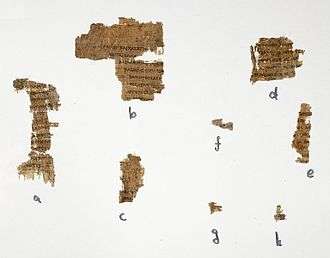Papyrus Rylands 458

Papyrus Rylands 458 is a copy of the Pentateuch in a Greek version of the Hebrew Bible known as the Septuagint. It is a papyrus manuscript in roll form. The manuscript has been assigned palaeographically to the 2nd century BC and it is the oldest known manuscript of the Greek Bible. The manuscript has survived in very fragmentary condition.
Description
The text was written on papyrus in uncial letters. It is designated by the number 957 on the list of Septuagint manuscripts according to the numbering system devised by Alfred Rahlfs. The surviving texts of the Book of Deuteronomy are verses Deut 23:24(26)–24:3; 25:1–3; 26:12; 26:17–19; 28:31–33; 27:15; 28:2.[1]
The manuscript consists of only 8 small fragments, designated by the letters "a"–"h". Fragment "h" is the smallest and contains only two letters. The words are not divided by spaces, but written continuously. The writer uses the colometrical system, regularly leaving a space at the end of sentence or clause.[1]
The text of the manuscript agrees more with the Codex Cottonianus than with the Codex Vaticanus.[2]
The manuscript has been used in discussions about the Tetragrammaton, although there are actually blank spaces in the places where some scholars such as C. H. Roberts believe that it contained letters.[3] According to Paul E. Kahle, the Tetragrammaton must have been written in the manuscript where these breaks or blank spaces appear.[4]
History of the scroll
Palaeographically the manuscript has been assigned to the mid-2nd century BC. It is the oldest known manuscript of the Septuagint. It is believed it came from Fayyum, where there were two Jewish synagogues.[1]
The manuscript was discovered in 1917 by J. Rendel Harris. It was examined by A. Vacari (1936) and A. Pietersma (1985).[1] The text was edited by C. H. Roberts in 1936.[5]
The manuscript is currently housed at the John Rylands Library (Gr. P. 458) in Manchester,[1] giving the manuscript its name.
See also
References
- 1 2 3 4 5 Würthwein Ernst (1988). Der Text des Alten Testaments, Stuttgart: Deutsche Bibelgesellschaft, p. 190.
- ↑ "Bible manuscripts", Rylands Papyri, UK: Katapi.
- ↑ Sidney Jellicoe (1968). The Septuagint and Modern Study. Eisenbrauns. pp. 271–2. ISBN 0-931464-00-5.
- ↑ Paul E. Kahle (1959). The Cairo Geniza. Oxford: Basil Blackwell. p. 222. ISBN 0758162456..
- ↑ Roberts, C. H. (1936) Two biblical Papyri in the John Rylands Library Manchester. Manchester 1936, p. 25.
Further reading
- Hans-Georg Opitz, and H. H. Schaeder, Zum Septuaginta-Papyrus Rylands Greek 458, ZNW (1936)
- Frederic G. Kenyon, Our Bible & the Ancient Manuscripts (4th Ed. 1939) Pg 63 & Plate VI.
- Würthwein, Ernst (1995). The text of the Old Testament: an introduction to the Biblia Hebraica. Wm. Eerdmans. p. 188. ISBN 0802807887.